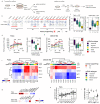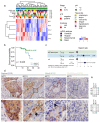mRNA Subtype of Cancer-Associated Fibroblasts Significantly Affects Key Characteristics of Head and Neck Cancer Cells
- PMID: 35565415
- PMCID: PMC9102192
- DOI: 10.3390/cancers14092286
mRNA Subtype of Cancer-Associated Fibroblasts Significantly Affects Key Characteristics of Head and Neck Cancer Cells
Abstract
Head and neck squamous cell carcinomas (HNSCC) belong among severe and highly complex malignant diseases showing a high level of heterogeneity and consequently also a variance in therapeutic response, regardless of clinical stage. Our study implies that the progression of HNSCC may be supported by cancer-associated fibroblasts (CAFs) in the tumour microenvironment (TME) and the heterogeneity of this disease may lie in the level of cooperation between CAFs and epithelial cancer cells, as communication between CAFs and epithelial cancer cells seems to be a key factor for the sustained growth of the tumour mass. In this study, we investigated how CAFs derived from tumours of different mRNA subtypes influence the proliferation of cancer cells and their metabolic and biomechanical reprogramming. We also investigated the clinicopathological significance of the expression of these metabolism-related genes in tissue samples of HNSCC patients to identify a possible gene signature typical for HNSCC progression. We found that the right kind of cooperation between cancer cells and CAFs is needed for tumour growth and progression, and only specific mRNA subtypes can support the growth of primary cancer cells or metastases. Specifically, during coculture, cancer cell colony supporting effect and effect of CAFs on cell stiffness of cancer cells are driven by the mRNA subtype of the tumour from which the CAFs are derived. The degree of colony-forming support is reflected in cancer cell glycolysis levels and lactate shuttle-related transporters.
Keywords: HNSCC; cancer; cancer-associated fibroblasts; cell stiffness; tumour microenvironment.
Conflict of interest statement
The authors declare no conflict of interest.
Figures





Similar articles
-
Identification and verification of eight cancer-associated fibroblasts related genes as a prognostic signature for head and neck squamous cell carcinoma.Heliyon. 2023 Feb 28;9(3):e14003. doi: 10.1016/j.heliyon.2023.e14003. eCollection 2023 Mar. Heliyon. 2023. PMID: 36938461 Free PMC article.
-
Cancer-associated fibroblasts secrete hypoxia-induced serglycin to promote head and neck squamous cell carcinoma tumor cell growth in vitro and in vivo by activating the Wnt/β-catenin pathway.Cell Oncol (Dordr). 2021 Jun;44(3):661-671. doi: 10.1007/s13402-021-00592-2. Epub 2021 Mar 2. Cell Oncol (Dordr). 2021. PMID: 33651283
-
The paracrine effect of cancer-associated fibroblast-induced interleukin-33 regulates the invasiveness of head and neck squamous cell carcinoma.J Pathol. 2013 Oct;231(2):180-9. doi: 10.1002/path.4226. Epub 2013 Aug 12. J Pathol. 2013. PMID: 23775566
-
Heterogeneity of cancer-associated fibroblasts in head and neck squamous cell carcinoma: opportunities and challenges.Cell Death Discov. 2023 Apr 13;9(1):124. doi: 10.1038/s41420-023-01428-8. Cell Death Discov. 2023. PMID: 37055382 Free PMC article. Review.
-
Crosstalk between CAFs and tumour cells in head and neck cancer.Cell Death Discov. 2024 Jun 26;10(1):303. doi: 10.1038/s41420-024-02053-9. Cell Death Discov. 2024. PMID: 38926351 Free PMC article. Review.
Cited by
-
Metabolic pathway-based subtypes associate glycan biosynthesis and treatment response in head and neck cancer.NPJ Precis Oncol. 2024 May 23;8(1):116. doi: 10.1038/s41698-024-00602-0. NPJ Precis Oncol. 2024. PMID: 38783045 Free PMC article.
-
Long-term zinc treatment alters the mechanical properties and metabolism of prostate cancer cells.Cancer Cell Int. 2024 Sep 11;24(1):313. doi: 10.1186/s12935-024-03495-y. Cancer Cell Int. 2024. PMID: 39261823 Free PMC article.
-
Integrating single-cell and bulk RNA sequencing to predict prognosis and immunotherapy response in prostate cancer.Sci Rep. 2023 Sep 20;13(1):15597. doi: 10.1038/s41598-023-42858-9. Sci Rep. 2023. PMID: 37730847 Free PMC article.
-
Glutamine and serum starvation alters the ATP production, oxidative stress, and abundance of mitochondrial RNAs in extracellular vesicles produced by cancer cells.Sci Rep. 2024 Oct 28;14(1):25815. doi: 10.1038/s41598-024-73943-2. Sci Rep. 2024. PMID: 39468126 Free PMC article.
-
RNA-Based Liquid Biopsy in Head and Neck Cancer.Cells. 2023 Jul 23;12(14):1916. doi: 10.3390/cells12141916. Cells. 2023. PMID: 37508579 Free PMC article. Review.
References
-
- Stewart B.W., Wild C.P. World Cancer Report 2014. WHO Press; Geneva, Switzerland: 2014.
-
- Kumar D., New J., Vishwakarma V., Joshi R., Enders J., Lin F., Dasari S., Gutierrez W.R., Leef G., Ponnurangam S., et al. Cancer-Associated Fibroblasts Drive Glycolysis in a Targetable Signaling Loop Implicated in Head and Neck Squamous Cell Carcinoma Progression. Cancer Res. 2018;78:3769–3782. doi: 10.1158/0008-5472.CAN-17-1076. - DOI - PMC - PubMed
Grants and funding
LinkOut - more resources
Full Text Sources

